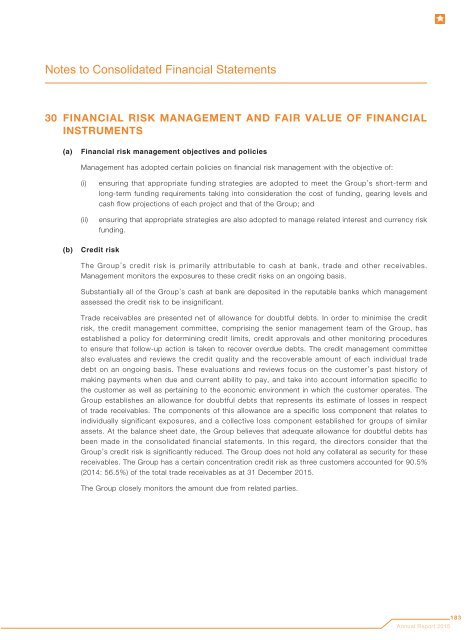ANNUAL%20REPORT%202015%20eng
ANNUAL%20REPORT%202015%20eng
ANNUAL%20REPORT%202015%20eng
You also want an ePaper? Increase the reach of your titles
YUMPU automatically turns print PDFs into web optimized ePapers that Google loves.
Notes to Consolidated Financial Statements<br />
30 FINANCIAL RISK MANAGEMENT AND FAIR VALUE OF FINANCIAL<br />
INSTRUMENTS<br />
(a)<br />
Financial risk management objectives and policies<br />
Management has adopted certain policies on financial risk management with the objective of:<br />
(i)<br />
(ii)<br />
ensuring that appropriate funding strategies are adopted to meet the Group’s short-term and<br />
long-term funding requirements taking into consideration the cost of funding, gearing levels and<br />
cash flow projections of each project and that of the Group; and<br />
ensuring that appropriate strategies are also adopted to manage related interest and currency risk<br />
funding.<br />
(b)<br />
Credit risk<br />
The Group’s credit risk is primarily attributable to cash at bank, trade and other receivables.<br />
Management monitors the exposures to these credit risks on an ongoing basis.<br />
Substantially all of the Group’s cash at bank are deposited in the reputable banks which management<br />
assessed the credit risk to be insignificant.<br />
Trade receivables are presented net of allowance for doubtful debts. In order to minimise the credit<br />
risk, the credit management committee, comprising the senior management team of the Group, has<br />
established a policy for determining credit limits, credit approvals and other monitoring procedures<br />
to ensure that follow-up action is taken to recover overdue debts. The credit management committee<br />
also evaluates and reviews the credit quality and the recoverable amount of each individual trade<br />
debt on an ongoing basis. These evaluations and reviews focus on the customer’s past history of<br />
making payments when due and current ability to pay, and take into account information specific to<br />
the customer as well as pertaining to the economic environment in which the customer operates. The<br />
Group establishes an allowance for doubtful debts that represents its estimate of losses in respect<br />
of trade receivables. The components of this allowance are a specific loss component that relates to<br />
individually significant exposures, and a collective loss component established for groups of similar<br />
assets. At the balance sheet date, the Group believes that adequate allowance for doubtful debts has<br />
been made in the consolidated financial statements. In this regard, the directors consider that the<br />
Group’s credit risk is significantly reduced. The Group does not hold any collateral as security for these<br />
receivables. The Group has a certain concentration credit risk as three customers accounted for 90.5%<br />
(2014: 56.5%) of the total trade receivables as at 31 December 2015.<br />
The Group closely monitors the amount due from related parties.<br />
Annual Report 2015<br />
183


